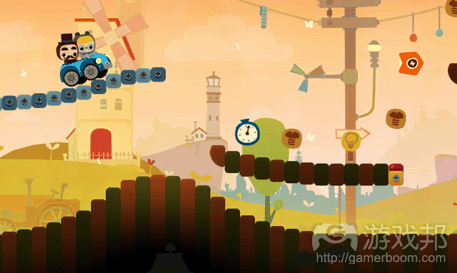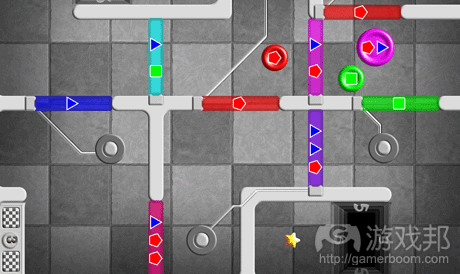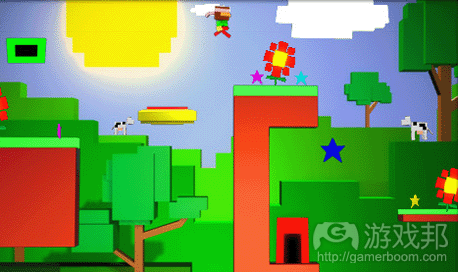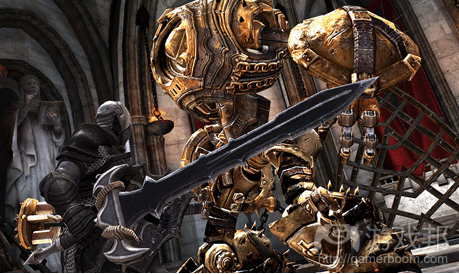触屏互动界面或成游戏未来发展方向
作者:Keith Stuart
触屏技术的诞生是电脑界面直观操作的一大转变。从任天堂DS到iPad,用户都充分享受此技术。通过手指操作屏幕道具非常自然。这使得用户从抽象按键操作中解放出来。
但这同时也说明游戏开发者需一段时间后才能适应这个新时代。40年来,互动娱乐方式都要通过操纵杆实现;设计主要由开关和按键支配。因此,当触屏智能手机和平板电脑问世时,很多工作室的最初反应是把既有机制转移至新设备,因此,虚拟手柄应运而生。
虚拟手柄坦率讲非常糟糕。分隔屏幕区块充当拇指垫和“按键”在小屏幕中根本行不通,此系统缺乏稳固触觉反馈。传统赛车和射击游戏依靠玩家同虚拟手柄所建立的共生关系,你需知晓模拟空间的极限,你需感觉按下按键。虚拟手柄无法实现此目的。
但幸运的是,时代已发生改变,我们开始步入触屏控制的黄金时代。
最明显的倡导者是物理益智游戏,此内容在过去1年异军突起。《愤怒的小鸟》和《割绳子》之类的作品几乎都采用直觉操作模式,玩家只需轻轻扫过屏幕,但其内容却不乏深度和多元化。Coatsink Software联合创始人Tom Beardsmore(游戏邦注:其负责开发触觉益智游戏《Pinch》)表示,“多数开发者都知道要去除中间环节,让加速器和触屏直接同屏幕游戏元素进行互动。这说明游戏类型有多少,界面操作方式就有多少。如今游戏领域已出现仅搭载触屏设备的全新游戏类型。”
Beardsmore认为融入触屏控制是渐进学习过程。“和鼠标与定位笔不同,在互动过程中,玩家手指在互动过程中会覆盖较大范围,没有实体按键,玩家就无法通过触觉找到自己想要的控制装置。他们需能看到自己手指所操作的屏幕。这个矛盾就在于触屏界面设计的核心。专业人士在此方面的作用很大,但若你和我们一样,无力聘请这样的人员,还有大量有关此内容的免费在线资料可供参考。坦白讲,我们也是边操作边学习!”
Paw Print Games主管Antony White赞同此互动模式。其工作室最近刚刚推出画面优美的《Kami Retro》,这是款平台益智游戏,玩家可通过扫射和点击控制多个角色。他表示,“我们投入大把时间完善手势系统。我们进行封闭测试,反复完善,一直到所获反馈都是正面评价。通过手势同时控制多个角色绝非易事。例如,当你轻弹角色令其跳跃起来时,其后面的一个角色会出现什么反应?他们都跳起来,还是只有最接近手势的角色跳起来?若你水平扫过两个角色,是只有最靠近的角色会转动,还是二者都转动?我们需询问自己许多诸如此类的问题。”
“在这些特殊例子中,我们最后决定当进行扫射跳跃操作时,只有一个角色受影响,但当进行扫射转动操作时,所有手势范围内的角色都会受影响。在完善这些手势系统和添加各种背景过滤器后,我们意识到需缩减原始角色数量,因为角色过于泛滥。4个Kami似乎是个合理标准,因此我们决定减少至4个。”
成功开发触屏游戏的要诀是学习和试验各种交互可能。驻扎萨里的工作室HotGen最近推出的《To-Fu: The Trials of Chi》是款基于触摸和拖曳理念的物理益智游戏。玩家能够在屏幕中拖曳和弹击游戏柔软主角。游戏首席设计师Stuart Ryall表示,“我们一直都希望创造无需额外按键、提示和修饰的核心机制。我喜欢看到玩家展开《To-Fu》,然后利用手指充当指示标记,而非用于展示轨迹或其他形式的反馈信息。我们省去任何屏幕提示或按键,我觉得游戏这样更好。”
开发者同时也在学习如何充分运用多点触控,此技术能够随时追踪多个玩家行为(游戏邦注:例如iPad设备最多能够同时进行10次触控,而iPhone则有5次)。Mobigame的《Cross Fingers》在此表现突出,玩家能够通过同时把握和操作多个模块完成系列谜题,但《割绳子》之类的游戏就有待进一步发展。
Ryall表示,“多点触控无疑有其发展空间。例如,它已经支持人们凭直觉通过两个手指缩展图片和网页。我觉得避免过分复杂化游戏,以及发现功能最大效用非常重要。RTS游戏(即时策略游戏)就是个典型例子,其中多点触控完美融入其中:使用多个手指操作单个单元或群组。”育碧就有个展示其策略游戏《Ruse》在微软桌面触控设备Surface运作情况的优秀视频。
杰出游戏开发二人组Simogo中的Magnus Gardebäck表示,其最新作品《Kosmo Spin》及表现卓越的《Bumpy Road》从头到尾都融入触控体验,这是游戏设计的核心元素。他表示,“良好出发点就是借助真正的OS界面。这在《Pinch》得到很好体现,游戏完全基于常见的双指缩放界面,这运用于许多智能手机UI中。这同时也是个富有吸引力的常见活动。
触屏和运动控制最有趣的元素在于开发者能够在其设计中融入横向跳跃。例如在《Bumpy Road》中,玩家能够通过手指抬高路面,移动汽车。这是个非常简单的构思,处理完美,但最终未能发行,因为开发者试图创造新型驾驶游戏,其中游戏起点完全依靠直觉。
Simogo另一成员Simon Flesser表示,“我们进行集体讨论时通常会联想日常事物和活动。例如,《Bumpy Road》的原始想法是用手指模拟制造海中浪花。然后大海就逐步变成道路。”
“我们通常会探讨愉快生理感觉,以及如何在游戏中捕捉这些感觉。在钢琴键盘上滑过手指是个非常美妙的体验,所以我们基本上会把它同‘制作浪花’理念结合起来,然后《Bumpy Road》就诞生了。”
有趣的是,如今我们发现很多主流掌机开发商也纷纷涉足这个领域,企图颠覆原有面貌。索尼NGP设备下方有触控输入衬垫。这说明玩家无需隐藏屏幕就能进行互动。索尼通过一款非常可爱的动作探险游戏《Little Deviants》展示此技术,玩家触动屏幕,游戏世界就会呈现小山丘,仿佛整个地貌是受玩家推挤形成的。
就像Paw Print Antony White所说的那样,“我最初看到的是些明显理念:通过控制基础触摸板调整玩家世界,或通过让玩家在空中弹击游戏元素,抑或是通过点击基础装置。设备有趣的一方面是其能够融入混合控制装置,允许创造性开发者采用最适合当前工作的控制系统。最终:我们无需坚持那些屏幕控制器!”
触屏控制装置开始转移手机领域,其角色不断演变。平板电脑PC快速变成主流技术,不断有新成员加入摩托罗拉Xoom、黑莓PlayBook和iPad的平板电脑世界。娱乐业的未来态势是:平板电脑成为起居室必备设备,同电视屏幕相互连接。
或许我们会使用触屏平板电脑充当游戏大屏直觉控制器;若有人想要观看电视节目,游戏内容就会转移至平板电脑屏幕,因为所有内容都基于云端。这似乎是任天堂Wii后续作品背后的理念,其当前代号为Project Café,设备计划于今年的E3大会发布。有传言称,新设备将植入具有触控屏幕以及标准按键和D衬垫的控制器。
当我询问开发者有关触控装置未来问题时,得到系列有趣理论。Beardsmore表示,“几年前,我看到一则诺基亚宣传录像,其使用纳米技术调节触控屏幕的物理形状。此设备屏幕按键隆起,以便玩家感觉。我觉得此触觉反馈是我们当前技术所缺乏的重要内容。目前我们只能作用两种用户感觉:视觉和听觉。触控设备通过触觉向用户反馈信息似乎是个固有功能。我们同此最接近的技术是植入某些设备的振动功能,但我们的沟通程度仅限于此。”
Simon Flesser同意这点。“能够模拟阻力和摩擦力是触屏或定点笔未来的发展出路。现已存在某些案例。”微软人机界面研究员Johnny Lee已创造能够运作于触屏,提供实体反馈的定位笔。Flesser还谈到试验“触觉记忆游戏”《MudPad》及日本研究员Junji Watanabe研发的杰出触控界面(游戏邦注:其能够通过手指所触摸的设备发送准确触控信号)。
触控界面也开始进军商业领域。Motiv是Immersion Corporation推出的触控技术,该公司主要涉猎存在于虚拟手柄的音效技术。Motiv促使Android手机制造商能够在其手机屏幕中创造触觉反馈功能,这样屏幕道具就能够同某些生理感官相伴而生。首个支持此技术的应用如今已问世,包括Keripo推出的音乐游戏《Beats Advanved Rhythm》和“攻击”益智游戏《Antigen》。
这些技术同笨拙而带有侵入性的传统虚拟手柄天差地别。就《Pinch》和《Bumpy Road》之类的游戏来说,其名字能够唤起生理动作和感官,这意味着未来触屏游戏将完全从控制装置中解放出来,甚至连传统游戏的设计动机也会发生变化。但这并不意味触控技术仅限于《愤怒的小鸟》之类休闲游戏:EA优秀智能手机版科幻射击游戏《死亡空间》充分运用扫射机制消灭敌人,Epic动作角色扮演游戏《无尽之剑》也非常亮眼。
触觉对人类体验而言非常重要,这是我们从小发现世界的方式;这是个我们无需不断重新学习的控制系统。虽然诸如Kinect和Wii之类的动作控制器能够让用户接触到物理界面,但我觉得触控才是游戏互动更准确且更具可塑性的未来。目前游戏利用有限的感官输入将成为未来发展方向。
有人曾说娱乐业的未来在于动作控制或3D,或者二者的结合体,但或许并非如此,其未来很可能是由感觉主导。(本文为游戏邦/gamerboom.com编译,如需转载请联系:游戏邦)
Touchscreens, smartphones and the haptic future of games
by Keith Stuart
How developers are learning to use intuitive movements and gestures to create a whole new generation of interactive experiences – and where this is all heading
The arrival of touchscreen technology must be one of the most intuitive computer interface transitions in history. From the Nintendo DS to the iPad, people have just got it. Physically manipulating onscreen items with our fingers is natural. It delivers users from the tyranny of abstract button operations.
But it’s telling that games developers took a while to adapt to this new era. For 40 years, interactive entertainment was about joysticks; design was governed by switches and buttons. Consequently, when touchscreen smartphones and tablets started to arrive, the initial instinct for many studios was to transplant those legacy systems onto the new devices – hence virtual joypads.
Virtual joypads are, to put it bluntly, horrible. Dividing off whole chunks of the screen space to act as thumb pads and “buttons” makes no sense on a small display, and the system lacks any remnants of solid, haptic feedback. Traditional racing and shooting games rely on the player developing a symbiotic relationship with the joypad – you need to know the extremes of the analogue radius, and you need to feel the buttons as they depress. The virtual joypad delivers none of this.
Fortunately, however, times have changed and we’re entering into a golden era of touch controls.
The most obvious proponents are the physics-based puzzlers that have risen to prominence over the last year. The likes of Angry Birds and Cut The Rope employ almost instinctive control models, based around mere swipes of the screen, but they are married with considerable gameplay depth and variety. “Most developers have learned to cut out the middle-man and allow the accelerometer and touchscreen to interact directly with the game elements that the user sees on-screen,” says Tom Beardsmore, co-founder of Coatsink Software, responsible for the brilliantly tactile puzzler, Pinch. “This has meant that there are as many ways to use this interface as there are types of games. Now we have brand new genres that can only be played on a touchscreen.”
According to Beardsmore, embracing touch has been a gradual learning process. “Unlike a mouse or stylus, a user’s finger will be covering a significant portion of the display while they interact, and without physical buttons/keys, the user cannot use their sense of touch to find the controls they want. They must rely on being able to see the display that they’re obscuring with their own finger. This paradox is at the core of touchscreen interface design. A specialist will help considerably in this area, but if, like us, you can’t afford one, there is also plenty of documentation on the subject available online for free. We’ve learned as we’ve worked, to be honest!”
Antony White, director of Paw Print Games, concurs with this iterative approach. His studio has just released the beautiful Kami Retro, a platform puzzler in which players control multiple characters through swipes and taps. “We invested a lot of time evolving our gesture system,” he says. “We performed closed beta tests and worked in an iterative manner until all feedback we received was positive. Controlling multiple characters at once using gestures was never going to be easy. For instance, what happens when you flick to jump a character and there’s another one behind it? Do they both jump or should it only be the closest to the gesture that jumps? If you swipe horizontally through a couple of character should the closest turn or both? We asked ourselves many questions like this.
“For these specific cases, we decided that when flicking to jump, only one character would be affected but when swiping through to turn then all within the gesture would be affected. After evolving the gesture system and adding various context filters we realised we found we had to scale back the character numbers from the original because it simply became too insane. Four Kamis seemed a more manageable number so we settled on that.”
The key to success with developing touchscreen titles is learning and experimenting with the variety of interaction possibilities. The recently released physics puzzler, To-Fu: The Trials of Chi, by Surrey-based studio HotGen is specifically based around the concepts of touching and dragging. It features a pliable lead character that can be pulled and flicked across the screen. “We were always drawn to the idea of creating a core mechanic that didn’t require any additional buttons, prompts or overlays,” says the game’s lead designer, Stuart Ryall. “I love the fact that the player stretches To-Fu and then uses their finger as a guide-marker rather than showing a trajectory line or any other form of feedback. We avoided the need for any on-screen prompts or buttons and I think the game is better for that.”
Developers are also learning how to get the most out of multitouch screens, which can trace more than one user action at any time (a maximum of 10 touches on the iPad, for example, as opposed to five on the iPhone). Mobigame’s Cross Fingers was a leader here, allowing players to complete a series of puzzles by holding and manipulating several blocks at once, but titles like Cut the Rope have explored and developed the possibilities.
“Multi-touch definitely has its place,” says Ryall. “For example, it’s already become second nature to manipulate photos and web pages using two fingers to pinch and stretch. It feels completely normal. I think it’s important not to overcomplicate your game and recognise where a feature is most useful. RTS (Real Time Strategy) games are a good example of where multi-touch feels like a logical fit: using multiple fingers to control separate units and groups.” Indeed, there’s a great video of Ubisoft showing off the strategy title Ruse running on the Microsoft Surface tabletop touch device.
Magnus “Gordon” Gardebäck, one half of talented games development duo, Simogo, says that both of their recent titles Kosmo Spin and the absolutely sublime Bumpy Road, have had the touch experience written from scratch as the central design component. “The key to implementing intuitive touch controls is to focus on what the user expects,” he says. “A good starting point is to play around with the interface of the actual OS.” This goes right back to Pinch, which is based entirely around the familiar two-finger zoom interface employed in most smartphone UIs. It’s also a familiar, almost innate, grabbing action.
One of the most intriguing elements of touchscreen and motion control technologies is the way in which they have allowed developers to make lateral leaps in their approach to game design. In Bumpy Road, for example, players use their fingers to raise sections of a road surface in order to move a car. It’s a really simply idea, beautifully executed, and it didn’t come about because the developer was trying to create a new type of driving game – the starting point was entirely sensuous.
“We often think of everyday things and especially motions when we start to brain storm,” says Simon Flesser, the other half of Simogo. “For example, for Bumpy Road the original idea was to simulate building waves on the ocean with your finger. Somehow that ocean turned in to a road along the way.
“We often discuss physical sensations that just feel good, and how we can capture those in a game. Dragging your finger along a piano keyboard is one of those really nice sensations – so basically we merged it with the ‘making waves’ concept and voilá, Bumpy Road was born.”
Interestingly, we’re now seeing the major console players moving into this space and attempting to subvert it. The Sony NGP features a touch input pad on the underside of the device, meaning that players can interact with it without obscuring the screen. Sony has used a cute action adventure title named Little Deviants to show off the technology – here, the game world forms hills over the places where players put their fingers, almost as though they’re pushing the landscape up.
As Antony White at Paw Print says, “initially I can see some obvious ideas for being able to alter the world under the player by manipulating the touchpad on the base, or by allowing the player to bounce game elements up in the air (on screen) by tapping the base. One aspect of the device that is exciting is there is scope to have hybrid controls, allowing the creative developers to use the most appropriate control system for the task in hand. Finally: no need to persevere with those onscreen controllers!”
Touchscreen controls are also moving out of the handheld space, and their role is evolving. Tablet PCs are fast becoming a mainstream technology, with the likes of the Motorola Xoom, Blackberry PlayBook and iPad already being joined by cheaper generic models. The future of entertainment could easily be about tablets becoming a living room essential, interacting with the main TV screen.
Perhaps we’ll use the touchscreen tablet as an intuitive controller for games played on a large screen display; and if someone else comes in wanting to watch a TV programme, the game content could simply be transferred to the tablet screen, because all the content will be cloud-based. This seems to be the concept behind Nintendo’s Wii successor, currently codenamed Project Café and set to be revealed at E3 on Tuesday. It’s rumoured this new console will come with controllers that feature touchscreen displays as well as standard buttons and d-pads.
When I asked developers about the future of touch controls there are some fascinating theories. “A couple of years ago I saw a concept video for a Nokia phone that used nanotechnology to adjust the physical shape of its touch screen, ” says Beardsmore. “It literally raised buttons off of the screen so they could be felt. I think this kind of haptic feedback is an important part of touch interfacing that we are lacking in today’s technology. Right now we can really only interact with two of the user’s senses: sight and sound. It seems only natural that a touch device should be able to send information back to a user via their sense of touch. The closest thing we have to that is a vibration function on some devices, but there’s only so much we can communicate with that.”
Simon Flesser agrees. “Touchscreens or styluses that can simulate resistance and friction are probably future. There are some examples out there already.” Johnny Lee, a researcher in human computer interfaces at Microsoft has developed a haptic pen which works with touchscreen displays to provide physical feedback. Flesser also points toward the experimental ‘tactile memory game’ MudPad and the fascinating tactile interface developed by Japanese researcher, Junji Watanabe, which sends pinpoint haptic signals through a device that sits on your finger nail. There’s a video of it in action here.
Haptic interfaces are also reaching the commercial space. Motiv is a touchscreen technology developed by Immersion Corporation, the company responsible for a lot of the rumble technology featured in today’s joypads. Motiv allows Android phone manufacturers to build haptic feedback features into their handset displays, so onscreen items are accompanied by definable physical sensations. The first apps supporting the technology are coming out now, inlcuding the music game Beats Advanved Rhythm by Keripo, and the ‘attack-based’ puzzler, Antigen.
All of this is a million miles away from the clumsy and intrusive virtual joypads of old. With games like Pinch and Bumpy Road, their very names are evocative of physical movements and sensations – they hint at a future in which touchscreen games are entirely liberated from the controls and even the design impetuses of conventional titles. This doesn’t necessarily mean a future of “casual” titles like Angry Birds: EA’s excellent smartphone conversion of the sci-fi shooter Dead Space makes clever use of a wiping mechanic to disptach enemies, as does Epic’s visually impressive (and decidedly hardcore) action RPG, Infinity Blade.
Touch is central to the human experience, it’s how we discover the world as babies; it is a control system that we don’t have to continually re-learn. While motion controllers like Kinect and Wii offer a glimpse at physical interfaces, I think touchscreens hint at a more precise yet malleable future for game interactions. A sensory input that current games only exploit on a very basic level, could well be the guiding force going forward.
We’ve been told that the future of entertainment is motion control, or 3D, or both; but maybe not. The future may well be sensation.(Source:guardian)













































 闽公网安备35020302001549号
闽公网安备35020302001549号